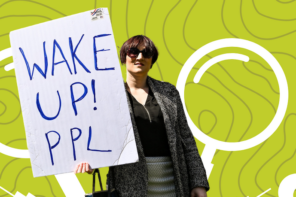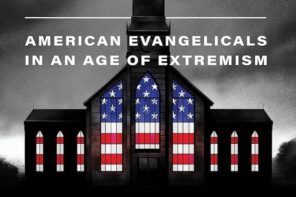On Monday, the nine members of the Hutaree Militia were charged with, among other things, ‘seditious conspiracy,’ which carries a maximum of a life imprisonment if convicted. The incident has raised concerns over domestic terrorism and left many confused about Christian apocalyptic belief, which requires some basic history to sort out.
The Hutaree [hoo-TAR-ee]—which means “Christian warrior” in the group’s secret language—were preparing “for the end time battles to keep the testimony of Jesus Christ alive.” They believed that “one day, as prophecy says, there will be an Antichrist. All Christians must know this and prepare, just as Christ commanded.” And they obliged by forming a citizens’ militia underground cell and arming themselves. Their plans, according federal officials, began in August 2008.
In order to explain why the Hutaree militia was arming itself to battle the Antichrist and federal law enforcement we need to explore the intersection of Christian fundamentalist apocalypticism with citizen militias, the Patriot Movement, and right-wing populism.
Something Old and Something New (World Order)
Conspiracy theories date back many centuries, with a major outbreak in the late 1790s of plots by Freemasons to smash both church and state. These plots were rewritten in the latter part of the 1800s to target Catholics; then by a sector of the Populists who saw the perpetrators as a giant octopus of plutocrats and bankers; and again in the early 1900s to scapegoat Jews. Talk radio pioneer Father Coughlin railed against the ‘banksters’ and Jews working behind the scenes in the Roosevelt Administration.
Since the early 1990s, a sector of the political right in the United States has embraced a specific set of conspiracy theories revolving around government plans to impose tyranny through the United Nations or some such international body. These conspiracy theorists, egged on by groups like the John Birch Society, claimed that George H.W. Bush was planning a New World Order before attacking the Clinton administration for political assassinations and drug running. The storyline morphed in recent years into fears that the government of the United States planned to destroy national sovereignty by merging with Mexico and Canada to form a North American Union. That theory first surfaced among right-wing opponents of President George W. Bush. Along the way, right-wing media demagogues and Republican Party activists and elected officials fanned the flames.
Now as the Obama administration enters its second year, these conspiracy theories have led to aggression and violence and an alleged domestic terrorist plot. Why is anyone surprised? The widespread public dualist demonization of scapegoated targets has a sordid and violent history. It has happened here. Some fundamentalist Christians portray the government as in league with the Satanic Antichrist in the prophetic End Times.
Christian Apocalypticism and Fundamentalism
An “apocalypse” in its simplest generic sense is an approaching struggle between good and evil during which hidden truths are revealed and the course of history is dramatically altered. Major Protestant denominations, the Catholic Church, and the Orthodox Churches embrace a soft form of Christian apocalyptic expectation, which in many cases refers back to prior historic periods. Some, though not all, Christian fundamentalists are imbued with heightened apocalyptic expectation about upcoming prophetic events.
Before the Puritans became colonists, “Protestant apocalyptic tradition envisioned the ultimate sacralization of England as God’s chosen nation,” observes Avihu Zakai in Exile and Kingdom. We tend to forget that the shining “city upon a hill,” was a beacon for a patriarchal Protestant theocracy that executed recidivist dissidents. The goal was to sanctify a new nation as the proper place for the prophesied return of Jesus the Christ. And the Civil War? “Mine eyes have seen the glory of the coming of the Lord?” See the narrative emerging?
Apocalyptic stories are an integral part of the American psyche, bleeding from theology into popular culture over the past two centuries: from Moby Dick to High Noon to Buffy the Vampire Slayer. Hal Lindsey (with C. C. Carlson) ignited the fuse of contemporary fundamentalist apocalyptic expectation with The Late Great Planet Earth published in 1970 by Zondervan.
Some 20-40 percent of the population of the United States tell pollsters that the biblical prophecies about an End Times battle between Godly Christians and the evil forces of Satan predict actual future history. About 10-15 percent of our neighbors say they hope to see the Second Coming of Jesus Christ in their lifetime. The numbers vary over time and due to the ways questions are structured. It is clear, however, that more people are excited by this type of apocalyptic belief than can be explained by counting the actual parishoners sitting in the pews in fundamentalist churches. Most of these folks, however, are not considering actual criminal acts or violence.
Brenda E. Brasher notes that apocalypticism can be constructive or destructive, pointing to the sustaining “role of apocalyptic Christianity among African slaves brought to the United States,” and in the “anti-slavery abolition movements and the Civil Rights movement.” However, if the scapegoated “other” is “constructed as wholly evil, then the ramifications are really horrendous,” warns Brasher.
“This is not a disagreement, but a struggle with evil incarnate, so there is no structure for a peaceful reconciliation” in which “people are cast in their roles as either enemy or friend and there is no such thing as middle ground,” Brasher explains, “In the battle with evil, can you really say you are neutral?”
The problem, then, is not Christian fundamentalism or apocalyptic belief per se but with forms of Christianity (or any religion) that condone or ignore scapegoating, fundamentalist movements that become totalitarian, or apocalypticism combined with dualistic demonization.
Where can we find this? I have a shelf of books published in the past 20 years in which right-wing fundamentalists warn of an impending apocalyptic battle pitting Godly Christians against sinful secular elites, those in favor of government social welfare programs, Muslims, New World Order internationalists seeking global cooperation, people working for peace, abortion providers, sinful homosexuals, and many more named scapegoats.
Militias, Tea Parties, and Right-Wing Populism
Why are there so many angry people? The Tea Parties are part of a broad Patriot Movement in the United States cobbled together from several preexisting formations on the political right:
- Economic libertarians who worry about big government collectivist tyranny.
- Christian Right Conservatives who oppose liberal government social policies
- Right-wing apocalyptic Christians who fear a Satanic New World Order
- Nebulous conspiracy theorists who fear a secular New World Order
- Nationalistic ultra-patriots concerned that US sovereignty is eroding.
- Xenophobic anti-immigrant white nationalists who worry about preserving the “real” America.
These grievances are interacting in a global economy often eager to accommodate corporate interests. And now we add in the fact that an economic downturn that has left millions unemployed or underemployed leaving the largely white, middle-class, Republican Tea Party activists scared that they may be kicked down the socioeconomic ladder next; the election of a “mixed-race” self-identified black man as president at a time when the demographics of the country reflect a growing percentage of people of color, all in the context of the unfinished conversation about race in America; and the disquiet among social conservatives who see abortion and gay rights through the lens of sin and immorality and anguish over the future of the family and traditional gender roles sometimes seen as mandated by God.
Spinning out of this broad Patriot movement that chronically appears throughout US history come armed citizens’ militias. The Militia Movement in the United States gained headlines in the mid 1990s. Like today, this earlier militia activism was part of a right-wing populist surge that ran from the Republican Party on the reform side to organized white supremacist groups on the insurgent side. This is not one unified movement, but a series of overlapping ones—think of the Olympic symbol of five interlocking rings. It’s quite plausible that sectors of the broad Patriot movement can work together on a common project without all of them actually agreeing on anything but stopping the secular liberal conspiracy to enslave America.
The story embraced by the armed militias in the 1990s was that the government of the United States was part of a secret plan to establish a One Word Government as part of building a New World Order. The debate at the Patriot and militia meetings I attended in the 1990s was whether or not the plot was controlled by the Freemasons, the Skull and Bones Society, the Corporate Elites, the Bilderbergers, or the agents of Satan in the End Times. Occasionally, someone would pull me aside and whisper that it was actually the Jews.
The ’90s militias are widely seen as part of a right-wing populist revolt against the administration of Democrat Bill Clinton, but it actually began under the administration of Republican George H.W. Bush, who was seen as a cosmopolitan internationalist eager to build the nefarious and tyrannical New World Order. Today’s militia activism can be traced in part to the North American Union conspiracy theory that percolated up during the last Bush Administration.
Is Obama the Antichrist or False Prophet?
Last July the following appeared on a Web post: “Obama is the false prophet, Javier Solana the Antichrist, add Satan and you have the unholy trinity. God help us all.” Republicans in New Jersey disagree, 29 percent of them think that Obama “is or might be the Antichrist.” Apparently the Hutaree Militia speculated that Javier Solana (the former Secretary General of NATO and the Secretary-General of the European Union) was the Antichrist, and that the US government merely played a supporting role in Satan’s evil End Times gambit.
As Robert C. Fuller observed in his classic Naming the Antichrist: The History of an American Obsession, the candidates for the starring roles vary over time in fundamentalist eschatological analysis. Some see Islam as the religion of the false prophet, the theological sidekick to the Antichrist. After 9/11 there was an increase in the demonization of Muslims in some Christian evangelical circles, especially those in which apocalyptic conspiracy theories flourish. For example, Hal Lindsey joined in the Islam-bashing in 2002 with The Everlasting Hatred: The Roots of Jihad. Speculation in conspiracy circles that Obama is secretly a Muslim, perhaps born in Kenya, add fuel to this bigoted fire.
Paul S. Boyer, author of When Time Shall Be No More: Prophecy Belief in Modern American Culture, suggests that religious views about biblical prophecy in the United States have “always had an enormous, if indirect and underrecognized, role [in] shaping public policy.” If the message of apocalyptic demonization is not clear, try reading one of the novels by Tim LaHaye and Jerry B. Jenkins in their Left Behind series of Christian apocalyptic novels which have sold more than 70 million copies.
Writing in the American Prospect, Gershom Gorenberg blasts the authors because they:
promote conspiracy theories; they demonize proponents of arms control, ecumenicalism, abortion rights and everyone else disliked by the Christian right; and they justify assassination as a political tool. Their anti-Jewishness is exceeded by their anti-Catholicism. Most basically, they reject the very idea of open, democratic debate. In the world of Left Behind, there exists a single truth, based on a purportedly literal reading of Scripture; anyone who disagrees with that truth is deceived or evil.
The main villain of the Left Behind series of books, Gorenberg notes, is “Nicolae Carpathia, the man who turned the United Nations into a one-world government with himself as dictator,” on behalf of Satan. In fact, Carpathia is the dreaded Antichrist. According to Gorenberg:
Perhaps the most striking scene in the Left Behind series is the climax of book six, The Assassins [when] Carpathia is speaking at a mass rally in Jerusalem. Out in the crowd is [underground Christian resistance leader] Rayford Steele, armed with a high-tech handgun. He prays for God’s guidance, and finds himself firing what appears to be a fatal shot at Carpathia. Intentionally or not, this is an eerie rewrite of Israeli Prime Minister Yitzhak Rabin’s assassination at a Tel Aviv peace rally in 1995—but the authors are on the side of the fanatic killer.
These types of conspiracy theories swirl through the Tea Party movement and into others on both the Christian and non-Christian Right. Before his novels, LaHaye wrote a series of books popular in the Christian Right in which he laid out the master plan of the conspiracy of liberal secular humanists. Big government and collectivism was part of the sinister plan. LaHaye claims it was Satan who arranged the “crafty election of Franklin D. Roosevelt as president for twelve years.” This was part of a secret conspiracy to turn the “American Constitution upside-down,” in order to “use our freedoms to promote pornography, homosexuality, immorality, and a host of evils characteristic of the last days.” LaHaye says the “Antichrist philosophy already controls America and Europe,” and that:
We are the only nation that can halt the socialist Marxist enthronement of the UN as THE GLOBAL GOVERNMENT of the world, but it will require a conservative administration and Supreme Court committed to judicially interpreting our nation’s laws that were originally based on moral biblical principles.
When the Tea Party activists warn that Obama’s big government policies will lead to totalitarian rule so that Obama is like both Hitler and Stalin, they’re likely drawing from the writings of free-market economic libertarian Friedrich August von Hayek or those theories as transmogrified by the conspiracist John Birch Society. When the Tea Party activists warn that Obama’s health care plan will pull the plug on grandma, they’re likely drawing from the anti-abortion and anti-euthanasia writings of conservative Christian philosopher Francis Schaeffer or those theories as refracted through the lens of apocalyptic Christian conspiracy theorists such as Tim LaHaye and Pat Robertson. So while the Tea Party movement and the armed militia movement may not be exactly on the same page, they are torn from the same essay on right-wing populism.
‘Extreme’ Demonization
The government has a legitimate law enforcement role in stopping domestic terrorism, though most dissidents on the political right and left are not breaking any laws and are protected by the First Amendment. The current and volatile right-wing populist movement spans from reform-oriented conservative black Republicans to recruiters for insurgent white supremacist groups, with the Tea Party activists and members of citizens militias falling somewhere between these ideological and methodological poles. It would be sloppy to lump all of these folks into one undifferentiated mass of potential terrorists.
The word “extremism,” which is tossed back and forth by both Republicans and Democrats, is a delegitimizing buzz word used by to demonize dissidents across the political spectrum. It was used in the 1960s, for example, to imply that the white segregationists and the Rev. Dr. Martin Luther King, Jr. were two sides of the same problem of “extremism.” King addressed being framed in this way in his “Letter from Birmingham Jail.” Today the government uses the tem “extremism” to suggest dissident ideas on the right or left place people on a slippery slope toward terrorism. It’s time to stop using the term altogether.
The dynamic of widespread political demonization and scapegoating is not a problem for the police to solve. Religious, political, business, and labor leaders have to find a backbone and demand an end to the demonization of political opponents as traitors out to destroy America. Republicans need to distance themselves from conspiracist demagoguery and accept some moral responsibility for the nasty polarization in our society while Democrats must stop dismissing the angry right-wing populists in the Tea Party movement as ignorant and crazy. All of us need to stand up and call for a vigorous, thoughtful, and even raucous national debate over public policy while opposing all forms of demonization and scapegoating as toxic to democracy.




